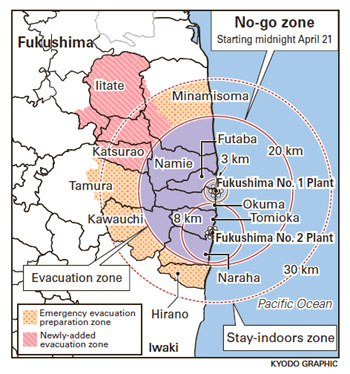Nuclear evacuation zone to be widened
Evacuation zone to be widened
Cumulative radiation levels feared to pose threat to residents: Edano
Prime Minister Naoto Kan’s government on Friday instructed parts of Fukushima Prefecture outside the 20-km no-go zone around the crippled No. 1 nuclear plant to evacuate by the end of May, saying that cumulative radiation levels may pose a health risk to residents.
The announcement came a day after the government declared the area a legally binding no-go zone, where unauthorized entry is subject to fines of up to ¥100,000 or possible detention for up to 30 days under a special nuclear emergency law.
Subject to the order are the villages of Iitate and Katsurao, the town of Namie and parts of the city of Minamisoma and the town of Kawamata.
“If people continue to live in the area, the cumulative radiation level may exceed 20 millisieverts a year,” said Chief Cabinet Secretary Yukio Edano. “Considering the effect it may have on people’s health, we would like those people to evacuate to a different location in an orderly manner.”
Edano said the government will closely coordinate with Fukushima Prefecture and other local governments affected on the details of the evacuation.
Meanwhile, other areas in the 20- to 30-km radius not subject to evacuation were designated “emergency evacuation preparation zones,” where residents will be asked to prepare to flee in case the nuclear crisis at the Fukushima plant suddenly worsens.
The towns of Hirono and Naraha, the village of Kawauchi, and parts of the cities of Tamura and Minamisoma were designated as parts of such zones.
“In case of emergency, people in this zone will be asked to stay indoors or evacuate by themselves,” Edano said.
“For those who may find it difficult to do so, it would be better to evacuate beforehand.”
Edano said children, expectant mothers, those who require nursing care and those who are hospitalized should leave the area.
At the same time, the government lifted the order to remain indoors in the 20- to 30-km radius.
As a result, residents in the city of Iwaki, part of which was in the area asked to stay indoors and which was excluded from the new areas designated Friday, will have all restrictions lifted.
The Nuclear and Industrial Safety Agency said it is difficult to predict how long the residents would be asked to keep out.
“It is expected to continue until radioactive substances spreading from the Fukushima No. 1 nuclear plant are under control,” said Hidehiko Nishiyama, a NISA spokesman. “At present, it is difficult to say how long it will continue.”
Nishiyama said the government will do its utmost to accommodate residents’ requests concerning relocation. But as it will take some time to build temporary housing, many residents may at first be put up at hotels.
If residents want to ship their cattle out of the planned evacuation zones, the government will help check radiation levels and decontaminate wherever necessary. It will also monitor radiation levels in cattle even after they are processed for food.


don’t breath the air or eat the food. Not funny